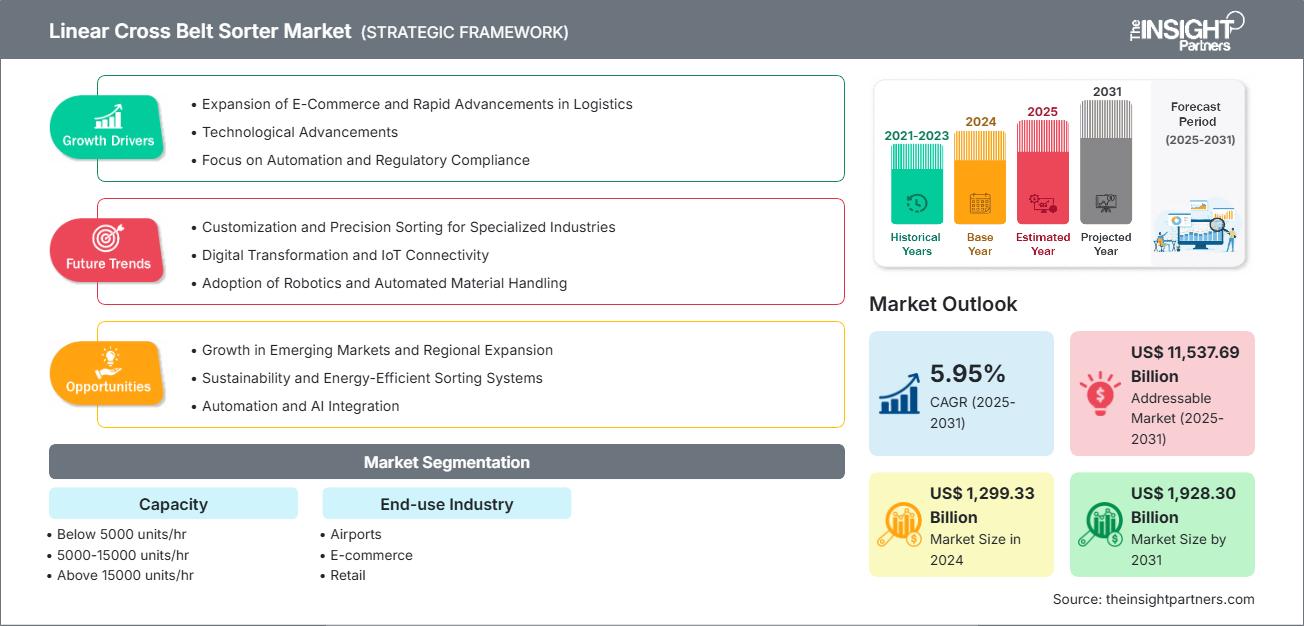线性交叉带分拣机市场规模预计将从 2024 年的 12.9933 亿美元增至 2031 年的 19.283 亿美元。预计 2025 年至 2031 年期间该市场的复合年增长率将达到 5.95%。
线性交叉带分拣机市场分析
市场的增长动力源于电子商务的快速扩张、供应链自动化趋势的需求增长以及对高效仓库运营的需求。物流、零售和制造等行业是线性交叉带分拣机的主要用户。此外,分拣技术的进步和对智能仓库的投资也推动了市场的增长。
线性交叉带分拣机市场概览
线性交叉带式分拣机是一种用于分拣和配送各种产品的物料搬运设备。这些分拣机将物品输送到传送带上,然后使用传感器和分流器将其分拣到不同的滑槽或通道中。这使得公司能够在仓库或配送中心快速高效地分拣和配送产品。
您将获得任何报告的免费定制,包括本报告的部分内容、国家级分析、Excel 数据包,以及为初创企业和大学提供优惠和折扣
线性交叉带分拣机市场:战略洞察

-
获取此报告的顶级关键市场趋势。此免费样品将包括数据分析,从市场趋势到估计和预测。
线性交叉带分拣机市场驱动因素和机遇
市场驱动因素:
- 电子商务的增长:电子商务的迅猛发展给电商带来了巨大的包裹配送压力。当日/次日送达的预期迫使分拣自动化,从而推动了市场的增长。
- 运营效率和成本降低:随着劳动力成本上升、劳动力短缺以及减少人工错误的愿望,公司正在投资自动分类以简化操作、减少对劳动力的依赖并提高产量。
- 新兴市场和基础设施投资的增长:亚太和拉丁美洲等地区正在投资物流基础设施、仓储和现代化配送中心;这些投资推动了对自动分拣系统的需求。
- 供应链复杂性:供应链日益复杂,对可追溯性(尤其是在制药/食品领域)、监管标准、批次跟踪等的需求日益增长,推动了能够精确分类、与仓库管理系统集成并保持数据完整性的系统的应用。
- 可持续性和能源效率:人们越来越意识到需要能耗更低、减少浪费且环保的设备,监管压力也越来越大。能耗更低且采用环境影响较小的材料制成的新型分选系统正变得越来越有吸引力。
市场机会:
- 仓库自动化和工业 4.0 应用:企业正在投资机器人、物联网和人工智能/机器学习等自动化技术,以简化物流运营。将线性交叉带分拣机与智能监控工具、预测性维护和机器人技术相结合,可以提高正常运行时间、增强可扩展性,并降低对劳动力的依赖。
- 技术创新:利用物联网传感器和人工智能进行预测性维护,可以减少停机时间和维护成本。实时决策:自适应路线规划、更智能的分拣路径等。
- 数字孪生和基于模拟的设计:在投资硬件之前,使用数字孪生(物理分拣机、仓库的虚拟复制品)来测试、优化和预测性能,有助于降低风险、削减成本和优化布局。
- 政府政策和基础设施推动:物流在各个国家被授予行业地位(更容易的融资、补贴、土地等)可能会带来更多的自动化投资(例如,西孟加拉邦授予物流业行业地位)。
- 冷链/温控分拣:对于易腐烂物品、药品、食品及类似商品而言,保持适宜的温度、防止变质并确保卫生至关重要。专为冷链或温控环境设计的分拣机代表着一个不断增长的细分市场,尤其是在热带气候和新兴市场。隔热、湿度控制和卫生表面材料等关键差异化因素为创新提供了机遇。
线性交叉带分拣机市场报告细分分析
线性交叉带分拣机市场细分为不同的细分市场,以便更清晰地了解其运作方式、增长潜力和最新趋势。以下是大多数行业报告中使用的标准细分方法:
按容量:
- 5000 件/小时以下:此产能的线性交叉带分拣主要适用于各行各业的中小型作业。它专注于提供经济高效且可靠的分拣解决方案。
- 5000–15000 单位/小时:需求量很大,因为它可以有效支持中高水平的批量操作。特定系统可以提供速度、准确性和可扩展性,这对电子商务、零售和第三方物流供应商很有帮助。
- 每小时 15000 单位以上:此部分适用于高吞吐量环境,包括大型电子商务中心和自动化配送中心。
按最终用户行业:
- 机场
- 电子商务、零售和时尚
- 食品和饮料
- 制造业
- 汽车
- 后勤
- 其他的
每个行业都有特定的物流和仓储要求。这会影响交叉带分拣机的采用和功能偏好。
按地理位置:
- 北美
- 欧洲
- 亚太地区
- 拉美
- 中东和非洲
亚太地区的线性交叉带分拣机市场预计将迎来最快的增长。对更快订单履行的需求、蓬勃发展的电商生态系统以及对蓬勃发展的电商生态系统的投资,都是可能推动市场增长的因素。
线性交叉带分拣机市场区域洞察
Insight Partners 的分析师已详尽阐述了预测期内影响线性交叉带分拣机市场的区域趋势和因素。本节还讨论了北美、欧洲、亚太地区、中东和非洲以及南美和中美洲的线性交叉带分拣机市场细分和地域分布。
线性交叉带分拣机市场报告范围
| 报告属性 | 细节 |
|---|---|
| 2024年的市场规模 | 12.9933亿美元 |
| 2031年的市场规模 | 19.283亿美元 |
| 全球复合年增长率(2025-2031) | 5.95% |
| 史料 | 2021-2023 |
| 预测期 | 2025-2031 |
| 涵盖的领域 |
按容量
|
| 覆盖地区和国家 |
北美
|
| 市场领导者和主要公司简介 |
|
线性交叉带分拣机市场参与者密度:了解其对业务动态的影响
线性交叉带分拣机市场正在快速增长,这得益于终端用户需求的不断增长,而这些需求的驱动因素包括消费者偏好的不断变化、技术进步以及对产品优势的认知度不断提高。随着需求的增长,企业正在扩展产品线,不断创新以满足消费者需求,并抓住新兴趋势,从而进一步推动市场增长。

- 获取线性交叉带分拣机市场主要参与者概览
线性交叉带分拣机市场份额(按地区)分析
预计未来几年亚太市场将增长最快。南美和中美以及中东和非洲等新兴市场也为线性交叉带分拣机供应商提供了许多尚未开发的扩张机会。
由于工业自动化程度、电子商务渗透率、劳动力成本、基础设施建设以及仓库现代化投资等因素的影响,各地区的线性交叉带分拣机市场增长情况存在差异。以下是各地区市场份额和趋势的摘要:
1. 北美
- 市场份额:占据全球市场的很大份额
-
关键驱动因素:
- 电子商务对仓库自动化的需求
- 网上购物的增长迫使零售商和物流公司采用自动分拣系统来满足高速订单履行的需求。线性交叉带分拣机等自动分拣系统使仓库和配送中心能够高效处理大量订单,从而减少处理时间和错误。
- 劳动力短缺推动对自动分拣解决方案的投资
- 大型物流和科技公司强势亮相
- 趋势:人工智能和物联网在分拣系统中的集成
2.欧洲
- 市场份额:由于早期采用数字商务,占据相当大的份额
-
关键驱动因素:
- 严格的劳动法鼓励自动化
- 严格的工时和劳动条件规定正促使企业走向自动化,以减少对人工的依赖并提高生产力。自动化分拣系统可帮助企业在满足法规要求的同时,提高生产力和一致性。
- 专注于可持续和节能的仓库运营
- 时尚和药品行业对精确、高速分拣的需求
- 趋势:智能仓储解决方案的投资
3. 亚太地区
- 市场份额:增长最快的地区,市场份额每年都在增长
-
关键驱动因素:
- 中国、印度和东南亚电子商务快速增长
- 中国、印度和东南亚的在线购物正在快速增长。这种激增催生了对可扩展、高速分拣解决方案的需求,以便高效地管理整个配送网络中不断增长的包裹量。
- 智能仓储和物流基础设施投资不断增加
- 增加制造业产出和出口活动
- 趋势:采用低成本、高效率的分拣系统
4. 南美洲和中美洲
- 市场份额:市场稳步增长
-
关键驱动因素:
- 供应链和物流的逐步数字化转型
- 不断增长的区域内贸易和分销网络
- 南美洲和中美洲地区贸易的不断增长,推动了对高效物流基础设施的需求。为了提高整个地区的配送速度和服务水平,需要增强分拣和配送能力。
- 部分国家政府对工业自动化的激励措施
- 趋势:本地化电商平台的兴起
5.中东和非洲
- 市场份额:虽然较小,但增长迅速
-
关键驱动因素:
- 不断增加对物流中心的投资,特别是在海湾合作委员会
- 中东地区,尤其是海湾地区,正在快速发展物流枢纽,力求成为全球贸易门户。这些枢纽需要先进的自动化分拣系统来高效处理大量货物,并支持其经济多元化计划。
- 基础设施现代化,支持经济多元化
- 零售和电子商务渗透率不断提高
- 趋势:智能物流园区的兴起
线性交叉带分拣机市场参与者密度:了解其对业务动态的影响
市场密度高,竞争激烈
由于FORTNA Inc.(美国)、Gosunm智能工业有限公司(中国)、Falcon Autotech Pvt Ltd.(印度)、杭州ConfirmWare科技有限公司(中国)、苏州百事记自动化设备有限公司(中国)、Fives SAS(法国)、Bastian Solutions LLC(美国)、BEUMER Group GmbH & Co. KG(德国)、Okura Yusoki Co., Ltd.(日本)和GINFON Group(中国)等老牌企业的存在,竞争十分激烈。
这种激烈的竞争促使公司通过提供以下产品脱颖而出:
- 高级安全功能
- 针对不同行业定制的可扩展解决方案
- 有竞争力的定价模式
- 全面的售后支持和服务
机遇与战略举措
- 制造商和系统集成商越来越多地与电子商务物流公司和第三方物流 (3PL) 合作,共同部署针对大包裹量优化的解决方案。
- 一些供应商将维护、软件升级和监控服务(通过物联网)捆绑在一起作为套餐的一部分,转向基于结果或基于绩效的合同。
- 节能环保的分类系统符合全球可持续发展目标和法规。
研究过程中分析的其他公司:
- Muvro 技术
- GBI内部物流解决方案
- 维之讯科技有限公司
- 深圳市高盛智能产业有限公司
- 百特康威自动化设备有限公司
- ZedSort(Muvro Technologies)
- 灰橙色
- 英特乐
- 德马泰克
- 范德兰德
- 西门子物流
- 伯曼集团
- 英特诺
- 瑞士仕格
线性交叉带分拣机市场新闻及最新发展
- Falcon Autotech 获 DTDC Express Ltd 选为其分拣机技术供应商 Falcon Autotech 是一家领先的内部物流自动化解决方案供应商,近日,该公司被印度领先的综合快递物流公司之一 DTDC Express Ltd 选中,为其位于泰米尔纳德邦钦奈 17.5 万平方英尺的超级枢纽实现包裹分拣作业的自动化。Falcon Autotech 利用其交叉带分拣机技术,为 DTDC 设计的包裹分拣系统每小时可处理 9,000 个包裹,全天候运行,并可根据未来业务增长进行扩展。
- 法孚宣布与 Agito 建立新的战略合作伙伴关系。高速分拣技术领域的全球领导者法孚宣布与包裹和物流领域值得信赖的自动化解决方案提供商 Agito 建立新的战略合作伙伴关系。此次合作标志着法孚在亚太地区(APAC)扩张的重要一步,尤其侧重于澳大利亚和新西兰。
- 重大并购:伯曼集团宣布收购亨德里克集团 伯曼集团宣布收购全球领先的气垫带式输送机公司之一亨德里克集团。通过此次收购,伯曼集团正在扩大其在散装物料运输领域的产品组合。
线性交叉带分拣机市场报告覆盖范围和交付成果
《线性交叉带分拣机市场规模和预测(2021-2031)》报告提供了涵盖以下领域的详细市场分析:
- 线性交叉带分拣机市场规模以及全球、区域和国家层面所有关键细分市场的预测
- 线性交叉带分拣机市场趋势,以及市场动态,例如驱动因素、限制因素和关键机遇
- 详细的 PEST 和 SWOT 分析
- 线性交叉带分拣机市场分析涵盖关键市场趋势、全球和区域框架、主要参与者、法规和最新市场发展
- 行业格局和竞争分析,涵盖市场集中度、热图分析、知名企业以及线性交叉带分拣机市场的最新发展
- 详细的公司简介
- 历史分析(2 年)、基准年、预测(7 年)及复合年增长率
- PEST和SWOT分析
- 市场规模、价值/数量 - 全球、区域、国家
- 行业和竞争格局
- Excel 数据集
近期报告
客户评价
购买理由
- 明智的决策
- 了解市场动态
- 竞争分析
- 客户洞察
- 市场预测
- 风险规避
- 战略规划
- 投资论证
- 识别新兴市场
- 优化营销策略
- 提升运营效率
- 顺应监管趋势






















 获取免费样品 - 线性交叉分拣机市场
获取免费样品 - 线性交叉分拣机市场